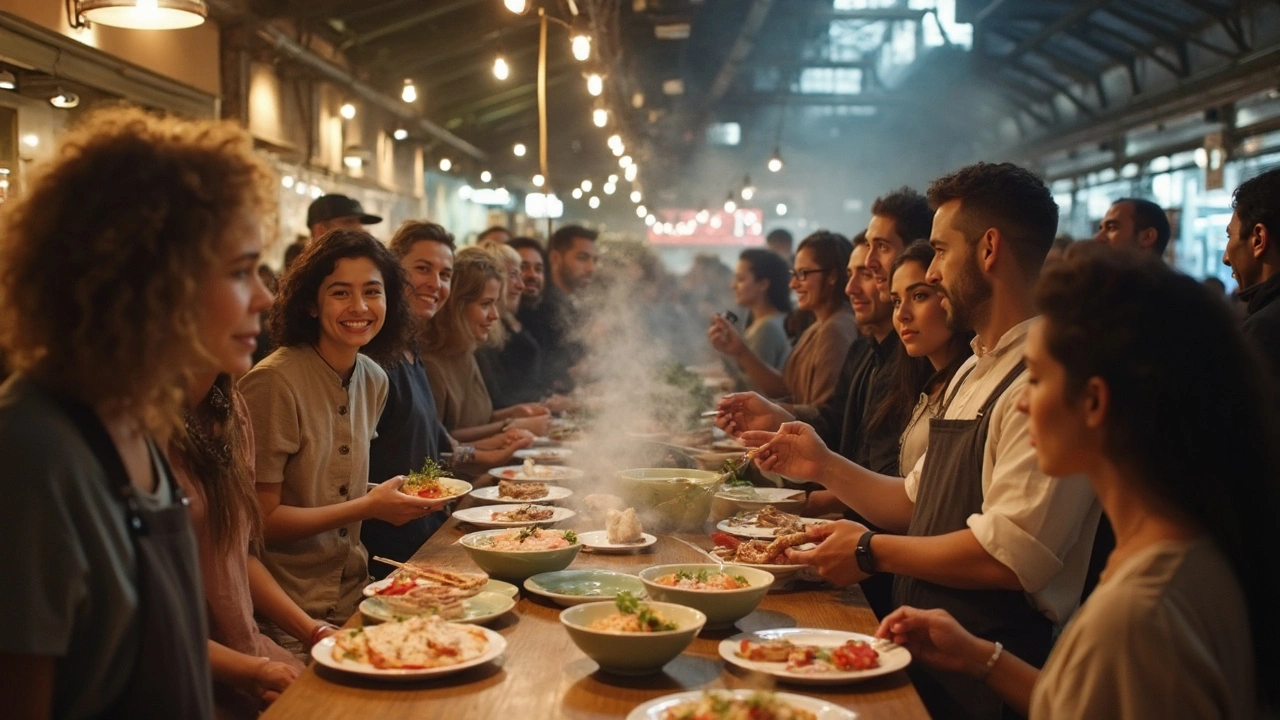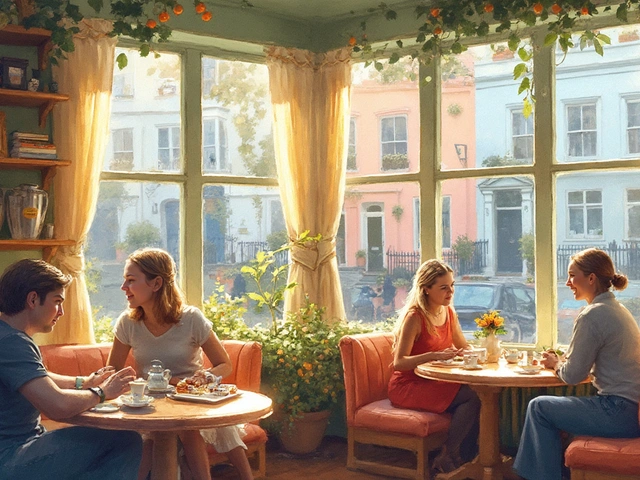If you think London’s just about fish and chips, you’re in for a surprise. London’s food scene is a wild playground for anyone with a sense of adventure. Right here in the heart of the city, you can bite into Ghanaian jollof rice in Brixton, chase Venezuelan arepas at Camden Market, or scoop up spicy Bangladeshi curries in Whitechapel.
The best part? You don’t need a passport—just a bit of curiosity and maybe a hearty appetite. Many London attractions double as food hotspots, with long-loved markets like Borough Market putting Ethiopian injera next to Cornish pasties. If you’ve got kids tagging along (trust me, Lucian’s all about new snacks) it’s even better—London does food adventures for all ages.
If you’re worried about making rookie mistakes, don’t be. Bring cash for smaller food stalls, and try to visit early if you want to avoid queues at places like Maltby Street Market. Always ask for a sample or recommendations—London vendors love to share their stories, and who knows, you might discover your new favourite dish. Keep an eye out for local pop-ups and events; there’s almost always something tasty happening somewhere. Hungry yet?
- Markets That Bring the World to Your Plate
- Street Food Adventures Across London
- Cooking Classes for Brave Foodies
- Underground Eateries and Pop-Ups
Markets That Bring the World to Your Plate
You could walk through London and eat around the globe without ever boarding a plane—if you know where to look. Start with the big name: Borough Market near London Bridge. This place is legendary, not just for the crowds, but for what you’ll find. Grab Ethiopian coffee, fresh Jamaican jerk chicken, or a gooey raclette sandwich from Kappacasein. Hungry for something new? Ask the stallholders what’s popular—chances are you’ll get a taste and a story.
Camden Market is another heavy hitter. You’ll spot Venezuelan arepas, giant Korean corn dogs, Turkish gözleme cooked on a hot griddle, and more bubble tea than you thought possible. Best to go hungry—portion sizes here aren’t shy. Most food counters offer vegetarian or vegan options too, which makes it easy if you’ve got different tastes in your group.
If you want something off the main tourist track, head to Maltby Street Market in Bermondsey. It’s smaller, but has a lineup of independent traders selling everything from Sri Lankan curries to sugar-dusted Portuguese pastel de nata. The market’s Ropewalk arches mean there’s shelter on rainy days, plus cool places for a pint once you’re done eating.
- Brick Lane Market is your ticket for Bangladeshi curries and sweet treats from Poland, with pop-ups swapping out every week.
- Brixton Village dishes up Afro-Caribbean, Japanese, and Colombian food all under one roof.
- Netil Market in London Fields offers top-rated tacos and creative global street food.
Here’s a quick look at what you’ll typically find in some of London's best food markets:
| Market | Must-Try Cuisine | Nearest Tube |
|---|---|---|
| Borough Market | Ethiopian, British cheese toasties | London Bridge |
| Camden Market | Venezuelan, Korean street food | Camden Town |
| Maltby Street | Sri Lankan, Spanish tapas | Bermondsey |
| Brixton Village | Caribbean, Colombian, Japanese | Brixton |
Most markets open by mid-morning and start winding down by 4pm. Cash and cards work, but it’s smart to keep a tenner or two handy, just in case a stall’s WiFi acts up. Come early for the best picks and shortest lines, especially on weekends. And don’t stress if the crowds make you feel lost—just go where you see a queue. In London, a queue usually leads to good food.
Street Food Adventures Across London
If you’re after big flavour without all the fuss, London’s street food scene is impossible to ignore. Start at Borough Market—it’s basically where the city’s obsession with food got serious, and you’ll find everything from Turkish gözleme to Spanish chorizo rolls. Weekends are busiest, so aim for a weekday if crowds put you off.
Camden Market is the go-to spot for those who like their lunch with a bit of live music or strange art. The arepas at Arepazo Bros, vegan Ethiopian platters, and Thai curry boxes are crowd favourites (Lucian swears by the hot churros for dessert, just don’t try to get one from Rufus). The market’s outdoor setting means you can wander, snack in hand, and just soak up the atmosphere.
Brick Lane has to be on your hit list, especially if you love bagels or crave real-deal South Asian flavours. Beigel Bake’s salt beef bagel has reached cult status, especially late at night (yes, it’s open 24/7). Don’t skip the line-up of Bangladeshi street vendors serving samosas and rolls—these are the real thing, packed with heat and flavour.
For something different, check out Kerb Markets. Multiple locations—South Bank, King’s Cross, or West India Quay—make it easy to find them wherever you are in the city. These rotating markets let new vendors show off their stuff, so it’s always changing, and you’ll find food from Colombia, Korea, Jamaica, you name it. Most have cashless stalls, so bring your card or phone for easy payment.
Some handy tips for making the most of London’s street food:
- Go with friends and share snacks if you want to taste more without getting stuffed.
- Food stalls are busiest from noon to 2 pm and on weekends—come early or go late for shorter queues.
- Bring napkins or grab some extras; the best eats are usually the messiest.
- Check Instagram or the vendor’s own website for daily specials or deals—they often pop up for a limited time.
Just so you can see how huge London street food has become, here’s a quick look at the number of stalls you might find at some of the city’s top markets:
| Market Name | Avg. Number of Stalls |
|---|---|
| Borough Market | 80+ |
| Camden Market | 60+ |
| Brick Lane | 40+ |
| KERB South Bank | 15-25 (rotates) |
The main thing? Don’t overthink it—just pick something that smells good and dig in. Your taste buds won’t judge you for being adventurous.

Cooking Classes for Brave Foodies
If eating your way around London food markets isn't enough, why not get your hands dirty and learn to cook dishes from around the globe? London’s cooking classes are everywhere, and they go way beyond the basics. From making Korean kimchi in Hackney to mastering Thai street food in Soho, there’s a class for every kind of adventurous eater.
The Jamie Oliver Cookery School up in Islington is a solid bet for those who want to nail homemade pasta or spice up their curry night. They’ve got courses on everything from Mexican street tacos to Vietnamese pho. Classes usually run three hours, and you’re eating as you go. If you’re after something more underground, Migrateful hosts classes run by refugees and migrants—here, you’ll pick up authentic recipes (and some pretty wild cooking stories) you won’t find in any supermarket cookbook. Lucian swears the Afghan dumpling class is life-changing.
If you don’t want to pay through the nose, check out Bread Ahead in Borough Market—focuses mainly on baking, but they sometimes throw in a world bread workshop. The South London-based Black Hand Social Club gets rave reviews for Turkish and Persian food sessions, and they always toss in a few local beers while you chop and chat.
Some classes cap numbers at ten, keeping things hands-on. Others, like School of Wok in Covent Garden, do large groups and full-day deep dives. Here’s a quick look at what’s on offer this month:
| Venue | Specialty | Price Range (£) | Typical Duration |
|---|---|---|---|
| Jamie Oliver Cookery School | Pasta, Asian, Tacos | 45-85 | 3 hours |
| Migrateful | African, Middle Eastern, South Asian | 35-65 | 2.5 hours |
| Bread Ahead | Breads, Baking | 90-120 | 4 hours |
| School of Wok | Chinese, Thai, Vietnamese | 65-120 | 2-5 hours |
Booking ahead is a must since weekends usually fill up fast. Also, double-check allergy policies—most places are good with swaps if you let them know. And don’t stress if you’re a total beginner. The teachers want you to succeed, not feel silly. It’s all about experimenting, learning, and—if you’re lucky—getting a recipe your friends will beg you to make again.
Underground Eateries and Pop-Ups
There’s a secret side to London food that only the boldest food lovers chase—underground restaurants and pop-up kitchens. Forget the high street for a night and hunt down a dinner party in someone’s flat or a supper club in a railway arch. These spots bring together total strangers and expert chefs for a couple hours, just for the love of adventurous eating. If you see names like The Gingerline or Supa Ya Ramen flash up on Insta, trust the hype. Gingerline has taken Londoners on secret dining journeys all over the Overground route—nobody knows what (or where) dinner is until you get your text with the address. Supa Ya Ramen, originally a home kitchen project in Hackney, turned so popular that it’s now booked solid whenever they announce a new address (watch for their ever-changing menu—last time, it was ‘BBQ eel fusion’!).
The pop-up scene changes quick, but a few tried-and-true tips will keep you in the know:
- Follow your favourite chefs, food collectives, and markets on social for real-time updates. A lot of spots don’t even list officially—word of mouth is king.
- Sign up for mailing lists on sites like Grub Club, London Pop-Ups, or Secret London.
- If a dinner needs booking in advance, don’t wait—seats go fast and there’s usually a long waiting list.
- Most have BYOB policies—makes the night cheaper and more relaxed.
- Check the address before you head out. A few are hidden behind laundrettes, in Shoreditch rooftops, or under railway arches in Bermondsey.
If you get a chance, check out global cuisine pop-ups popping up at events like Feast, Kerb, and Street Feast. You might run into a Colombian arepa maker one week and a Georgian khachapuri expert the next. A 2024 survey from Street Feast found 70% of diners came just to try something they’d never heard of before—that says it all about the local appetite for something different.
Underground restaurants and pop-ups are where food trends start—laksa made with British crab, or Taiwanese beef noodles with a Jamaican twist. These aren’t just meals; they’re a shortcut to London’s wildest food stories. That, plus you get bragging rights for finding a hidden gem before it goes mainstream.



